Adversarial Training for Aspect-Based Sentiment Analysis with BERT
Akbar Karimi,
Andrea Prati,
Leonardo Rossi
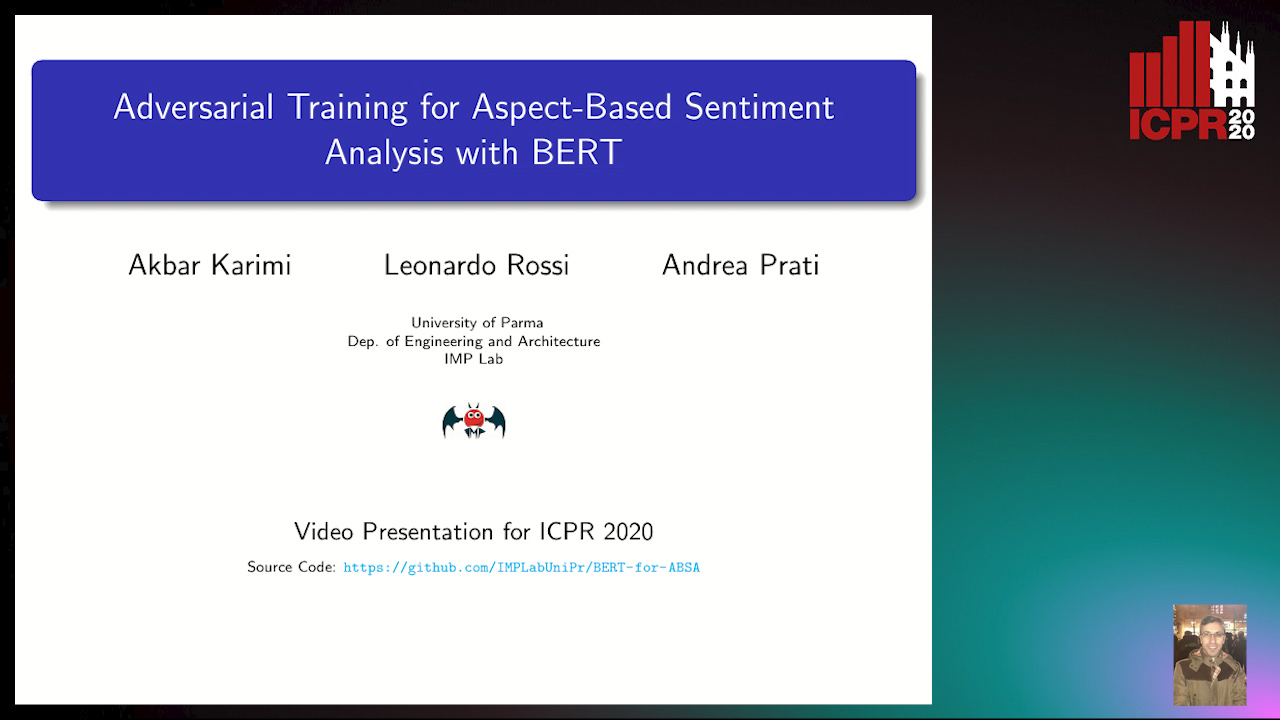
Auto-TLDR; Adversarial Training of BERT for Aspect-Based Sentiment Analysis
Similar papers
Evaluation of BERT and ALBERT Sentence Embedding Performance on Downstream NLP Tasks
Hyunjin Choi, Judong Kim, Seongho Joe, Youngjune Gwon

Auto-TLDR; Sentence Embedding Models for BERT and ALBERT: A Comparison and Evaluation
Abstract Slides Poster Similar
KoreALBERT: Pretraining a Lite BERT Model for Korean Language Understanding
Hyunjae Lee, Jaewoong Yun, Bongkyu Hwang, Seongho Joe, Seungjai Min, Youngjune Gwon

Auto-TLDR; KoreALBERT: A monolingual ALBERT model for Korean language understanding
Abstract Slides Poster Similar
Explain2Attack: Text Adversarial Attacks via Cross-Domain Interpretability
Mahmoud Hossam, Le Trung, He Zhao, Dinh Phung
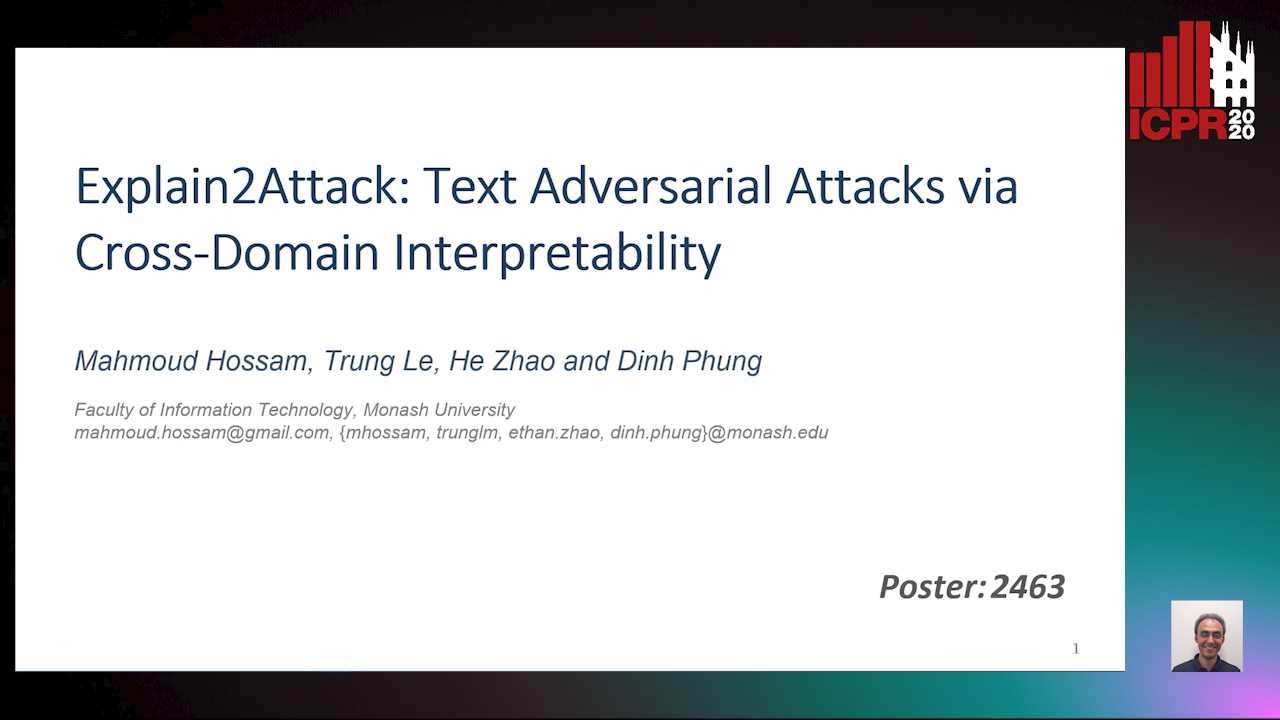
Auto-TLDR; Transfer2Attack: A Black-box Adversarial Attack on Text Classification
Abstract Slides Poster Similar
Sequential Domain Adaptation through Elastic Weight Consolidation for Sentiment Analysis
Avinash Madasu, Anvesh Rao Vijjini
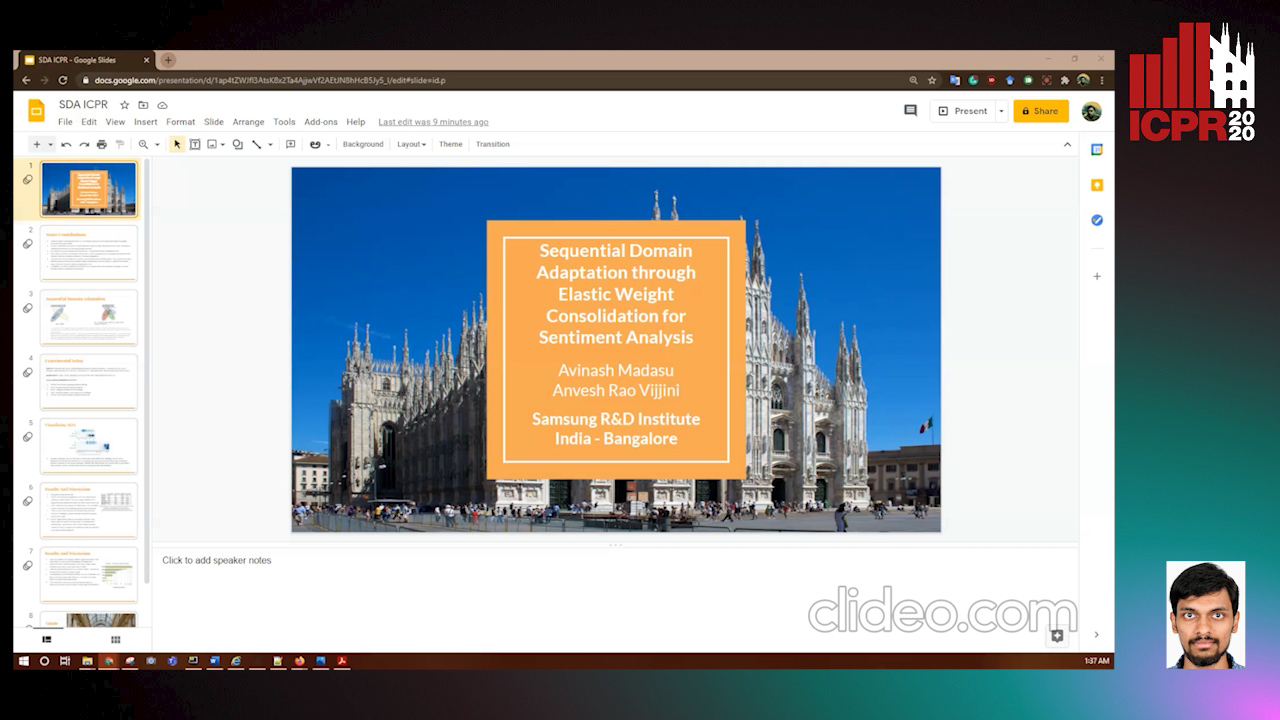
Auto-TLDR; Sequential Domain Adaptation using Elastic Weight Consolidation for Sentiment Analysis
Abstract Slides Poster Similar
Efficient Sentence Embedding Via Semantic Subspace Analysis
Bin Wang, Fenxiao Chen, Yun Cheng Wang, C.-C. Jay Kuo
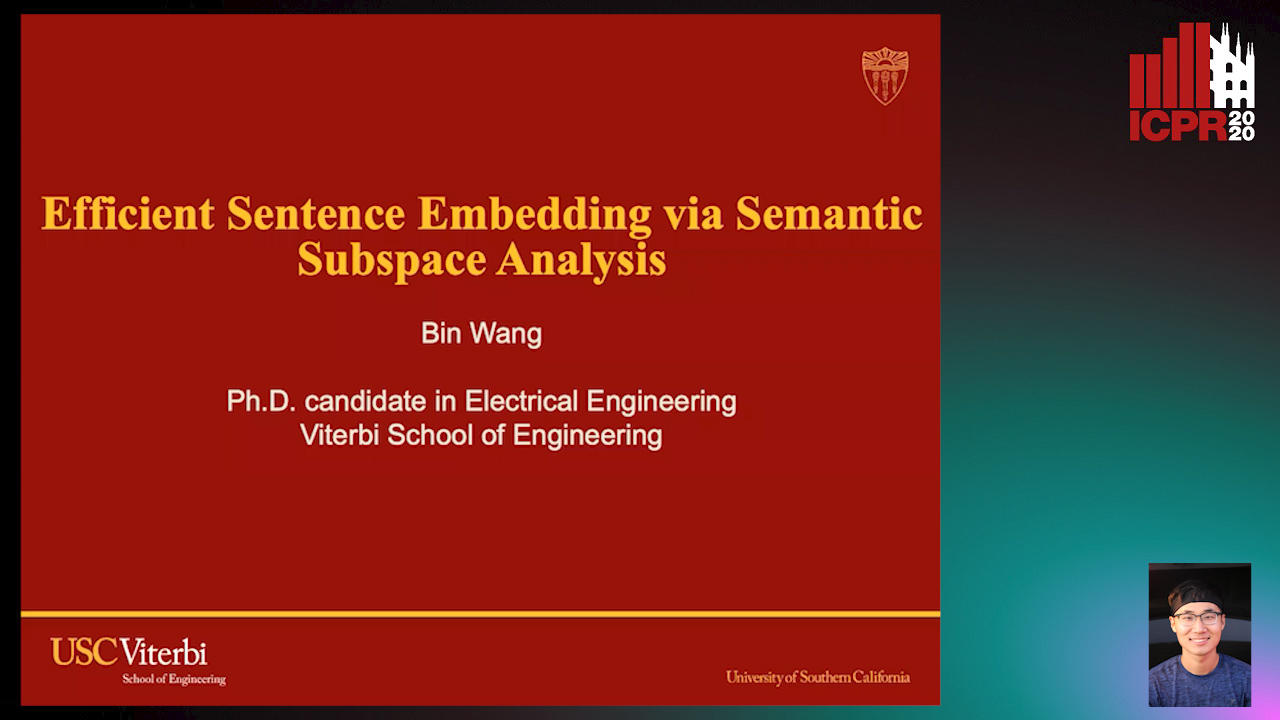
Auto-TLDR; S3E: Semantic Subspace Sentence Embedding
Abstract Slides Poster Similar
Assessing the Severity of Health States Based on Social Media Posts
Shweta Yadav, Joy Prakash Sain, Amit Sheth, Asif Ekbal, Sriparna Saha, Pushpak Bhattacharyya

Auto-TLDR; A Multiview Learning Framework for Assessment of Health State in Online Health Communities
Abstract Slides Poster Similar
Analyzing Zero-Shot Cross-Lingual Transfer in Supervised NLP Tasks
Hyunjin Choi, Judong Kim, Seongho Joe, Seungjai Min, Youngjune Gwon

Auto-TLDR; Cross-Lingual Language Model Pretraining for Zero-Shot Cross-lingual Transfer
Abstract Slides Poster Similar
PIN: A Novel Parallel Interactive Network for Spoken Language Understanding
Peilin Zhou, Zhiqi Huang, Fenglin Liu, Yuexian Zou

Auto-TLDR; Parallel Interactive Network for Spoken Language Understanding
Abstract Slides Poster Similar
GCNs-Based Context-Aware Short Text Similarity Model

Auto-TLDR; Context-Aware Graph Convolutional Network for Text Similarity
Abstract Slides Poster Similar
Automatic Student Network Search for Knowledge Distillation
Zhexi Zhang, Wei Zhu, Junchi Yan, Peng Gao, Guotong Xie

Auto-TLDR; NAS-KD: Knowledge Distillation for BERT
Abstract Slides Poster Similar
Tackling Contradiction Detection in German Using Machine Translation and End-To-End Recurrent Neural Networks
Maren Pielka, Rafet Sifa, Lars Patrick Hillebrand, David Biesner, Rajkumar Ramamurthy, Anna Ladi, Christian Bauckhage
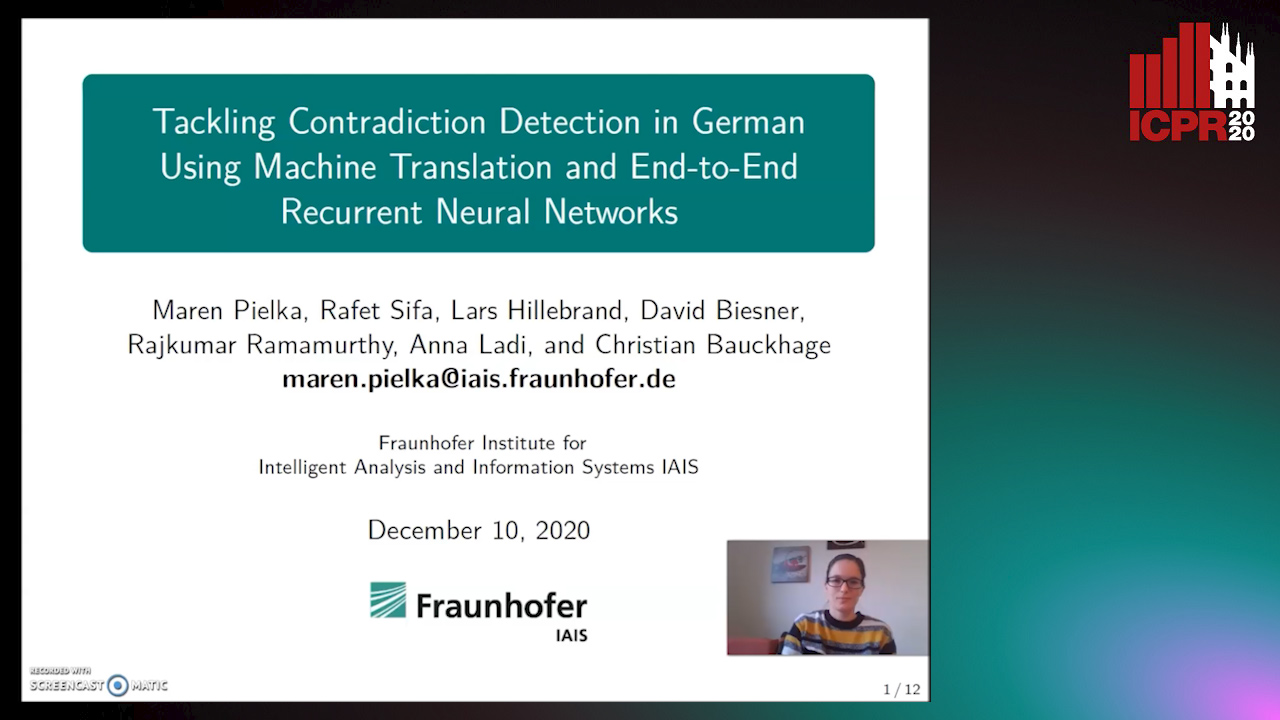
Auto-TLDR; Contradiction Detection in Natural Language Inference using Recurrent Neural Networks
Abstract Slides Poster Similar
CKG: Dynamic Representation Based on Context and Knowledge Graph
Xunzhu Tang, Tiezhu Sun, Rujie Zhu

Auto-TLDR; CKG: Dynamic Representation Based on Knowledge Graph for Language Sentences
Abstract Slides Poster Similar
Zero-Shot Text Classification with Semantically Extended Graph Convolutional Network
Tengfei Liu, Yongli Hu, Junbin Gao, Yanfeng Sun, Baocai Yin

Auto-TLDR; Semantically Extended Graph Convolutional Network for Zero-shot Text Classification
Abstract Slides Poster Similar
Learning Neural Textual Representations for Citation Recommendation
Thanh Binh Kieu, Inigo Jauregi Unanue, Son Bao Pham, Xuan-Hieu Phan, M. Piccardi

Auto-TLDR; Sentence-BERT cascaded with Siamese and triplet networks for citation recommendation
Abstract Slides Poster Similar
Label Incorporated Graph Neural Networks for Text Classification
Yuan Xin, Linli Xu, Junliang Guo, Jiquan Li, Xin Sheng, Yuanyuan Zhou

Auto-TLDR; Graph Neural Networks for Semi-supervised Text Classification
Abstract Slides Poster Similar
Mood Detection Analyzing Lyrics and Audio Signal Based on Deep Learning Architectures
Konstantinos Pyrovolakis, Paraskevi Tzouveli, Giorgos Stamou

Auto-TLDR; Automated Music Mood Detection using Music Information Retrieval
Abstract Slides Poster Similar
Segmenting Messy Text: Detecting Boundaries in Text Derived from Historical Newspaper Images

Auto-TLDR; Text Segmentation of Marriage Announcements Using Deep Learning-based Models
Abstract Slides Poster Similar
Trajectory-User Link with Attention Recurrent Networks
Tao Sun, Yongjun Xu, Fei Wang, Lin Wu, 塘文 钱, Zezhi Shao

Auto-TLDR; TULAR: Trajectory-User Link with Attention Recurrent Neural Networks
Abstract Slides Poster Similar
Reinforcement Learning with Dual Attention Guided Graph Convolution for Relation Extraction
Zhixin Li, Yaru Sun, Suqin Tang, Canlong Zhang, Huifang Ma

Auto-TLDR; Dual Attention Graph Convolutional Network for Relation Extraction
Abstract Slides Poster Similar
Dual Path Multi-Modal High-Order Features for Textual Content Based Visual Question Answering
Yanan Li, Yuetan Lin, Hongrui Zhao, Donghui Wang

Auto-TLDR; TextVQA: An End-to-End Visual Question Answering Model for Text-Based VQA
PICK: Processing Key Information Extraction from Documents Using Improved Graph Learning-Convolutional Networks
Wenwen Yu, Ning Lu, Xianbiao Qi, Ping Gong, Rong Xiao

Auto-TLDR; PICK: A Graph Learning Framework for Key Information Extraction from Documents
Abstract Slides Poster Similar
Text Synopsis Generation for Egocentric Videos
Aidean Sharghi, Niels Lobo, Mubarak Shah

Auto-TLDR; Egocentric Video Summarization Using Multi-task Learning for End-to-End Learning
Cross-Lingual Text Image Recognition Via Multi-Task Sequence to Sequence Learning
Zhuo Chen, Fei Yin, Xu-Yao Zhang, Qing Yang, Cheng-Lin Liu

Auto-TLDR; Cross-Lingual Text Image Recognition with Multi-task Learning
Abstract Slides Poster Similar
Adaptive Noise Injection for Training Stochastic Student Networks from Deterministic Teachers
Yi Xiang Marcus Tan, Yuval Elovici, Alexander Binder

Auto-TLDR; Adaptive Stochastic Networks for Adversarial Attacks
Multimodal Side-Tuning for Document Classification
Stefano Zingaro, Giuseppe Lisanti, Maurizio Gabbrielli

Auto-TLDR; Side-tuning for Multimodal Document Classification
Abstract Slides Poster Similar
A Novel Attention-Based Aggregation Function to Combine Vision and Language
Matteo Stefanini, Marcella Cornia, Lorenzo Baraldi, Rita Cucchiara

Auto-TLDR; Fully-Attentive Reduction for Vision and Language
Abstract Slides Poster Similar
Transformer Reasoning Network for Image-Text Matching and Retrieval
Nicola Messina, Fabrizio Falchi, Andrea Esuli, Giuseppe Amato

Auto-TLDR; A Transformer Encoder Reasoning Network for Image-Text Matching in Large-Scale Information Retrieval
Abstract Slides Poster Similar
Optimal Transport As a Defense against Adversarial Attacks
Quentin Bouniot, Romaric Audigier, Angélique Loesch
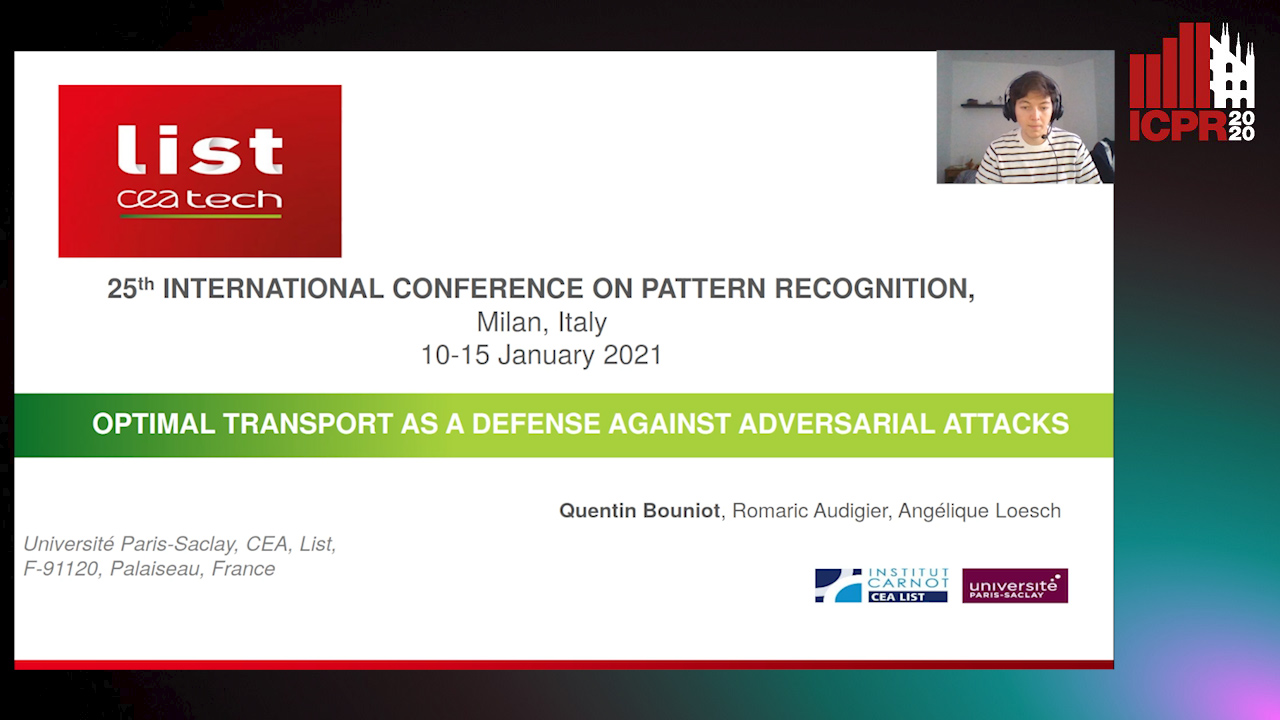
Auto-TLDR; Sinkhorn Adversarial Training with Optimal Transport Theory
Abstract Slides Poster Similar
Named Entity Recognition and Relation Extraction with Graph Neural Networks in Semi Structured Documents
Manuel Carbonell, Pau Riba, Mauricio Villegas, Alicia Fornés, Josep Llados

Auto-TLDR; Graph Neural Network for Entity Recognition and Relation Extraction in Semi-Structured Documents
Enriching Video Captions with Contextual Text
Philipp Rimle, Pelin Dogan, Markus Gross

Auto-TLDR; Contextualized Video Captioning Using Contextual Text
Abstract Slides Poster Similar
Attentive Visual Semantic Specialized Network for Video Captioning
Jesus Perez-Martin, Benjamin Bustos, Jorge Pérez

Auto-TLDR; Adaptive Visual Semantic Specialized Network for Video Captioning
Abstract Slides Poster Similar
Scientific Document Summarization using Citation Context and Multi-objective Optimization
Naveen Saini, Sushil Kumar, Sriparna Saha, Pushpak Bhattacharyya
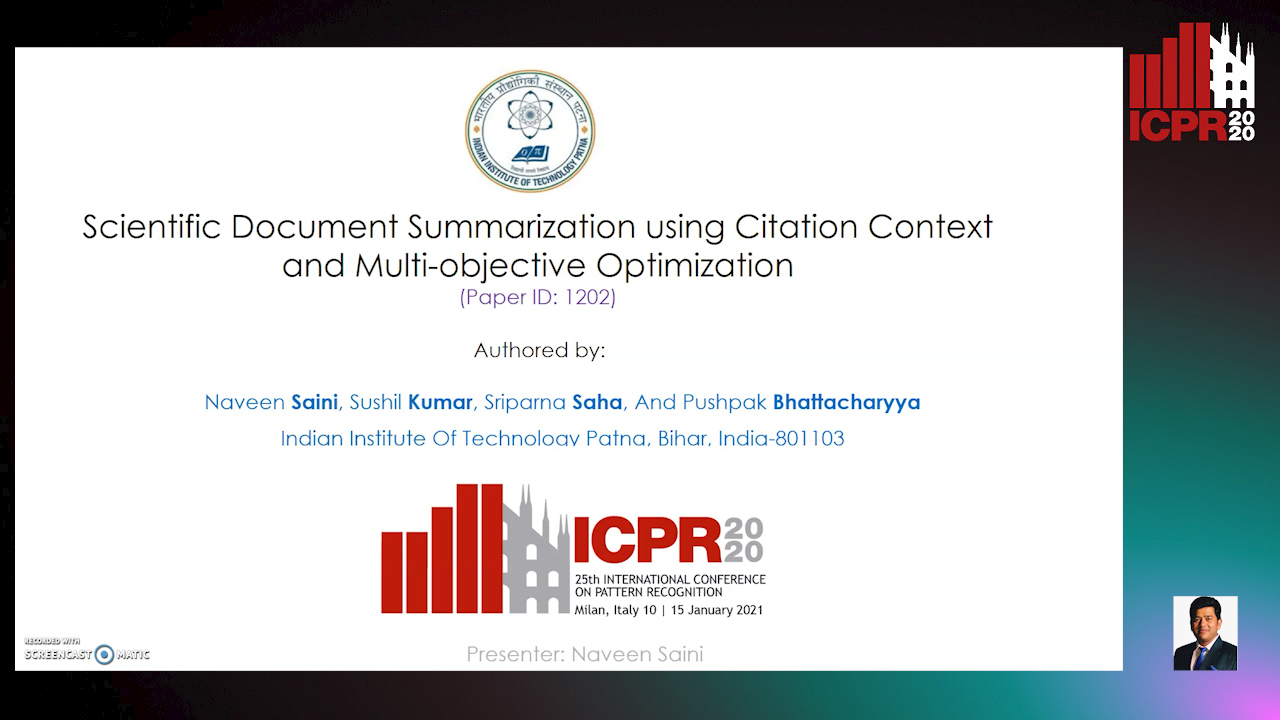
Auto-TLDR; SciSumm Summarization using Multi-Objective Optimization
Abstract Slides Poster Similar
Cross-Supervised Joint-Event-Extraction with Heterogeneous Information Networks
Yue Wang, Zhuo Xu, Yao Wan, Lu Bai, Lixin Cui, Qian Zhao, Edwin Hancock, Philip Yu
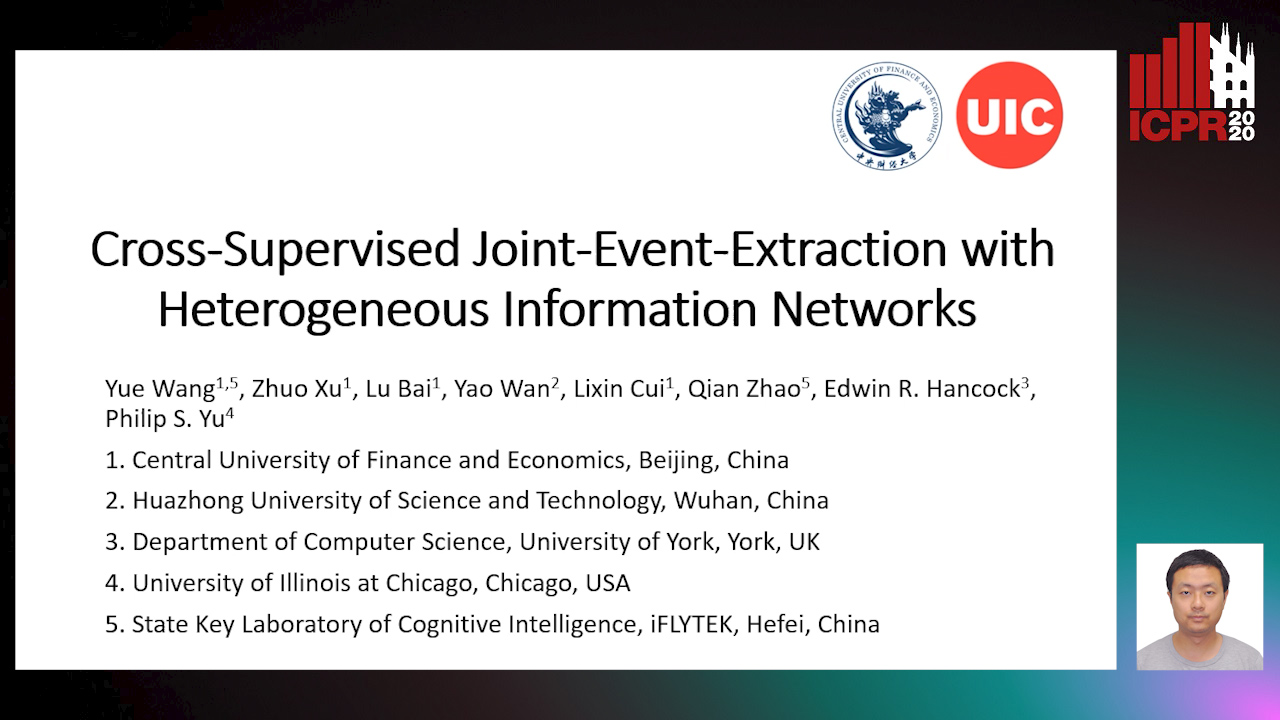
Auto-TLDR; Joint-Event-extraction from Unstructured corpora using Structural Information Network
Abstract Slides Poster Similar
Predicting Chemical Properties Using Self-Attention Multi-Task Learning Based on SMILES Representation

Auto-TLDR; Self-attention based Transformer-Variant Model for Chemical Compound Properties Prediction
Abstract Slides Poster Similar
Context Visual Information-Based Deliberation Network for Video Captioning
Min Lu, Xueyong Li, Caihua Liu

Auto-TLDR; Context visual information-based deliberation network for video captioning
Abstract Slides Poster Similar
Moto: Enhancing Embedding with Multiple Joint Factors for Chinese Text Classification
Xunzhu Tang, Rujie Zhu, Tiezhu Sun
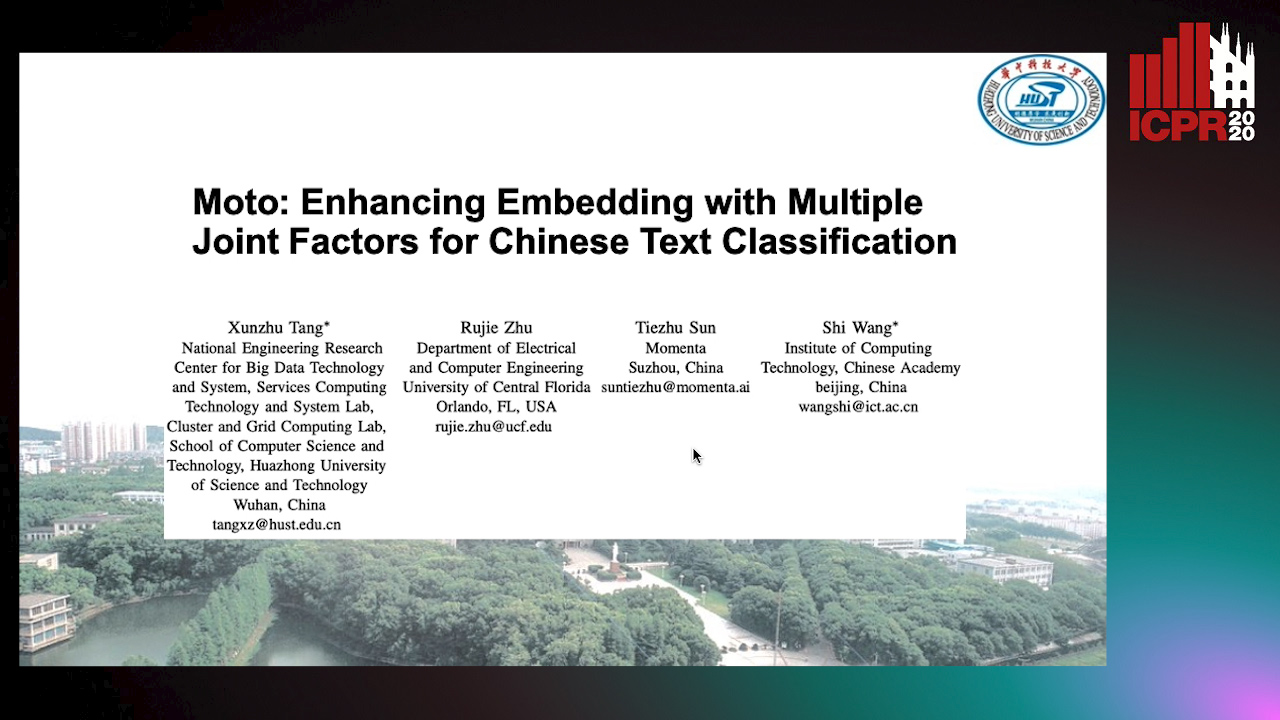
Auto-TLDR; Moto: Enhancing Embedding with Multiple J\textbf{o}int Fac\textBF{to}rs
Abstract Slides Poster Similar
Feature-Aware Unsupervised Learning with Joint Variational Attention and Automatic Clustering
Wang Ru, Lin Li, Peipei Wang, Liu Peiyu

Auto-TLDR; Deep Variational Attention Encoder-Decoder for Clustering
Abstract Slides Poster Similar
Attack-Agnostic Adversarial Detection on Medical Data Using Explainable Machine Learning
Matthew Watson, Noura Al Moubayed

Auto-TLDR; Explainability-based Detection of Adversarial Samples on EHR and Chest X-Ray Data
Abstract Slides Poster Similar
Task-based Focal Loss for Adversarially Robust Meta-Learning
Yufan Hou, Lixin Zou, Weidong Liu

Auto-TLDR; Task-based Adversarial Focal Loss for Few-shot Meta-Learner
Abstract Slides Poster Similar
Beyond Cross-Entropy: Learning Highly Separable Feature Distributions for Robust and Accurate Classification
Arslan Ali, Andrea Migliorati, Tiziano Bianchi, Enrico Magli

Auto-TLDR; Gaussian class-conditional simplex loss for adversarial robust multiclass classifiers
Abstract Slides Poster Similar
Cost-Effective Adversarial Attacks against Scene Text Recognition
Mingkun Yang, Haitian Zheng, Xiang Bai, Jiebo Luo

Auto-TLDR; Adversarial Attacks on Scene Text Recognition
Abstract Slides Poster Similar
Leveraging Sequential Pattern Information for Active Learning from Sequential Data
Raul Fidalgo-Merino, Lorenzo Gabrielli, Enrico Checchi
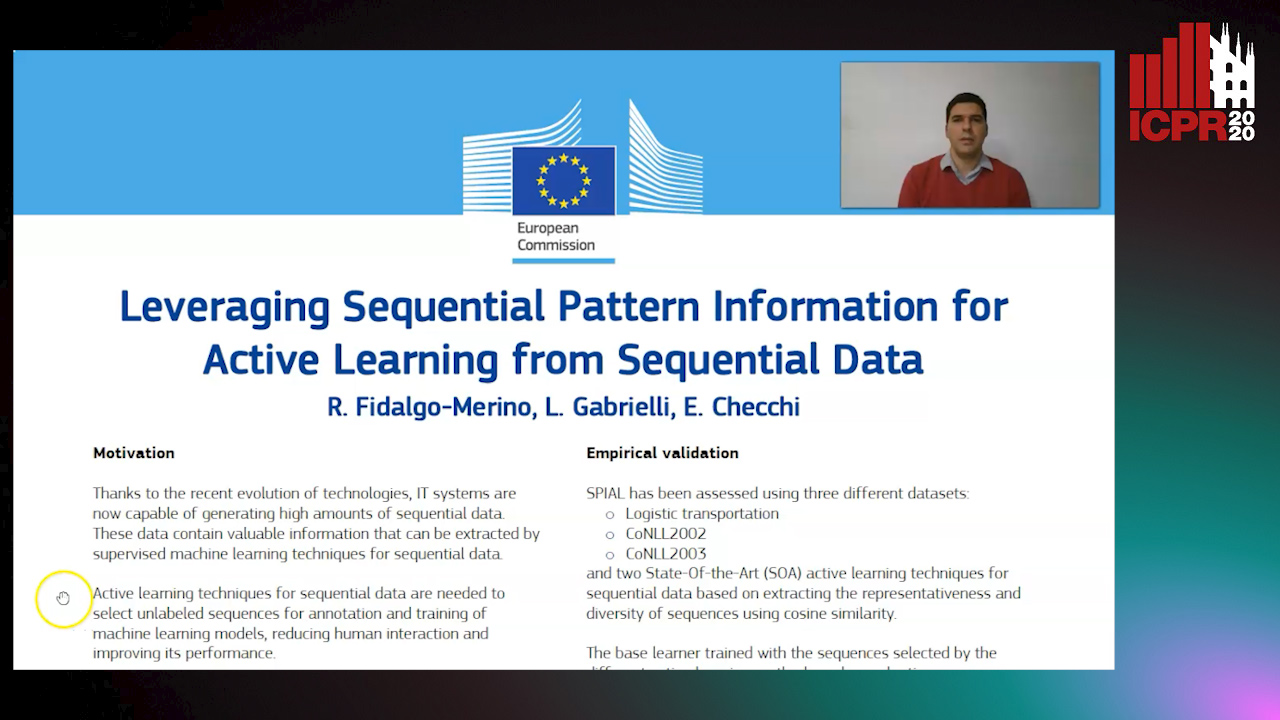
Auto-TLDR; Sequential Pattern Information for Active Learning
Abstract Slides Poster Similar
Transformer-Encoder Detector Module: Using Context to Improve Robustness to Adversarial Attacks on Object Detection
Faisal Alamri, Sinan Kalkan, Nicolas Pugeault
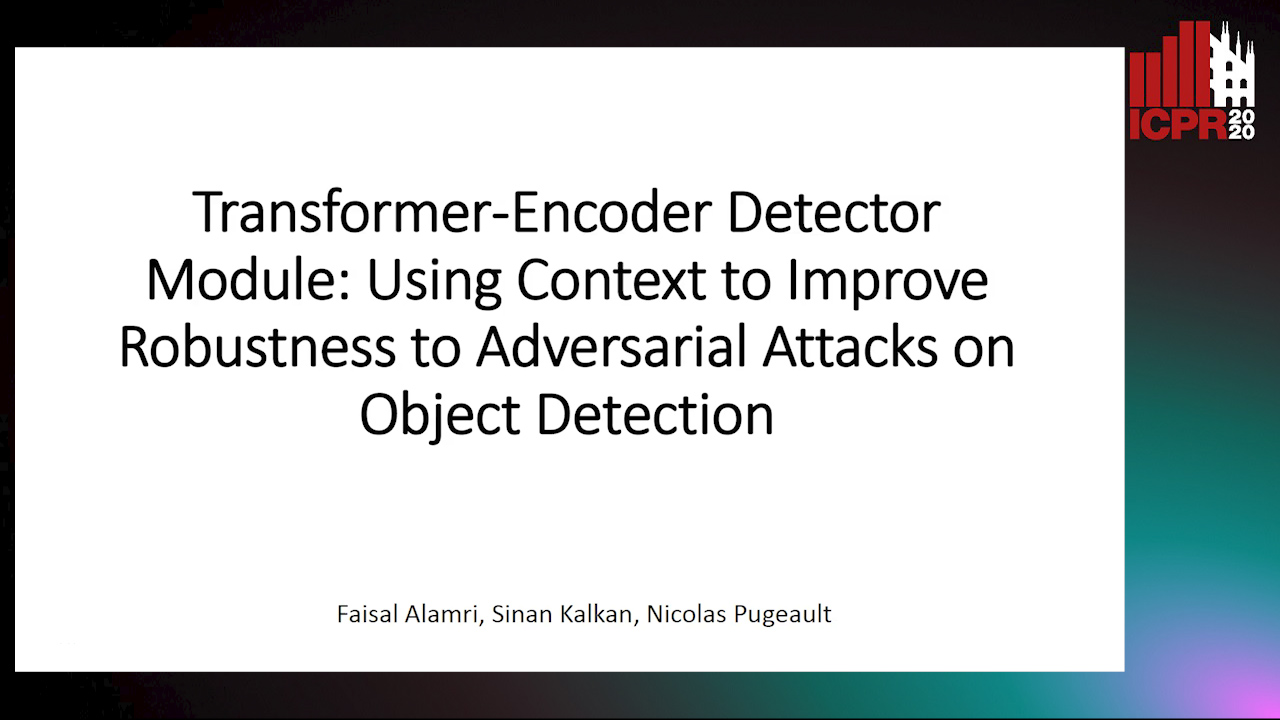
Auto-TLDR; Context Module for Robust Object Detection with Transformer-Encoder Detector Module
Abstract Slides Poster Similar
Transformer Networks for Trajectory Forecasting
Francesco Giuliari, Hasan Irtiza, Marco Cristani, Fabio Galasso

Auto-TLDR; TransformerNetworks for Trajectory Prediction of People Interactions
Abstract Slides Poster Similar
Global Context-Based Network with Transformer for Image2latex
Nuo Pang, Chun Yang, Xiaobin Zhu, Jixuan Li, Xu-Cheng Yin

Auto-TLDR; Image2latex with Global Context block and Transformer
Abstract Slides Poster Similar
Heuristics for Evaluation of AI Generated Music
Edmund Dervakos, Giorgos Filandrianos, Giorgos Stamou
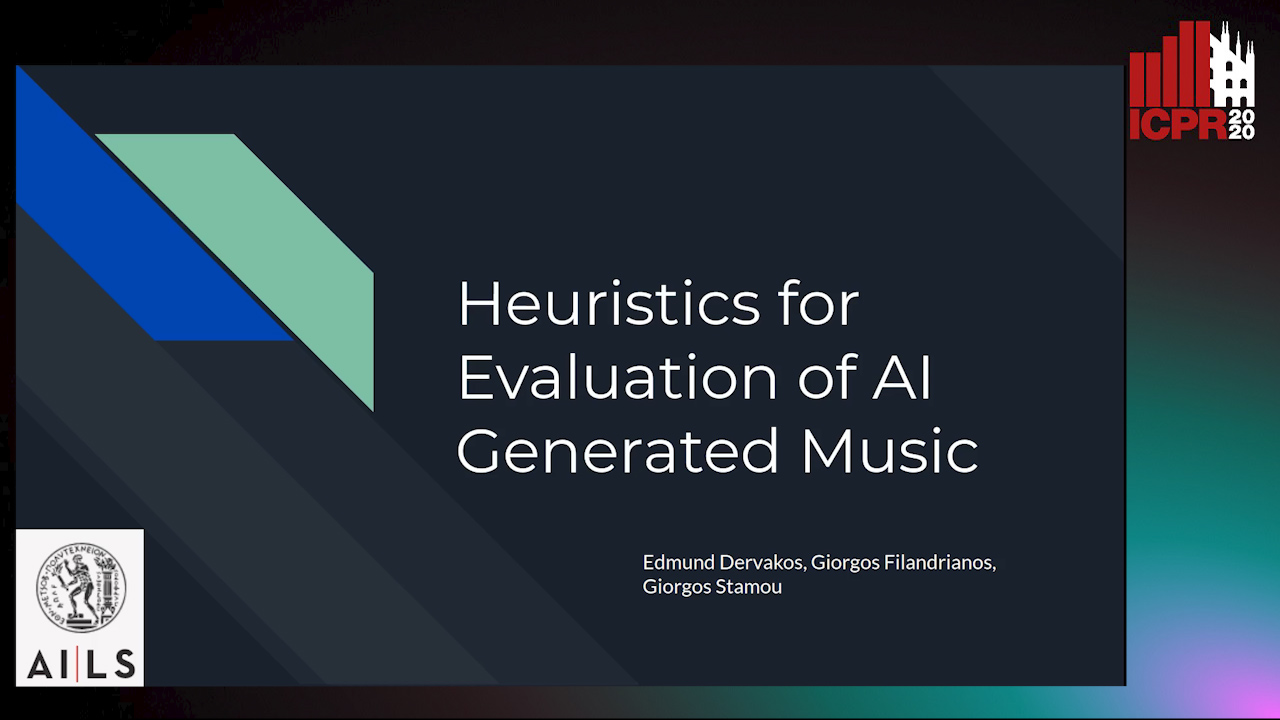
Auto-TLDR; Evaluation of generative models in the symbolic music domain using the circle of fifths
Abstract Slides Poster Similar
Adversarially Training for Audio Classifiers
Raymel Alfonso Sallo, Mohammad Esmaeilpour, Patrick Cardinal

Auto-TLDR; Adversarially Training for Robust Neural Networks against Adversarial Attacks
Abstract Slides Poster Similar
MA-LSTM: A Multi-Attention Based LSTM for Complex Pattern Extraction
Jingjie Guo, Kelang Tian, Kejiang Ye, Cheng-Zhong Xu
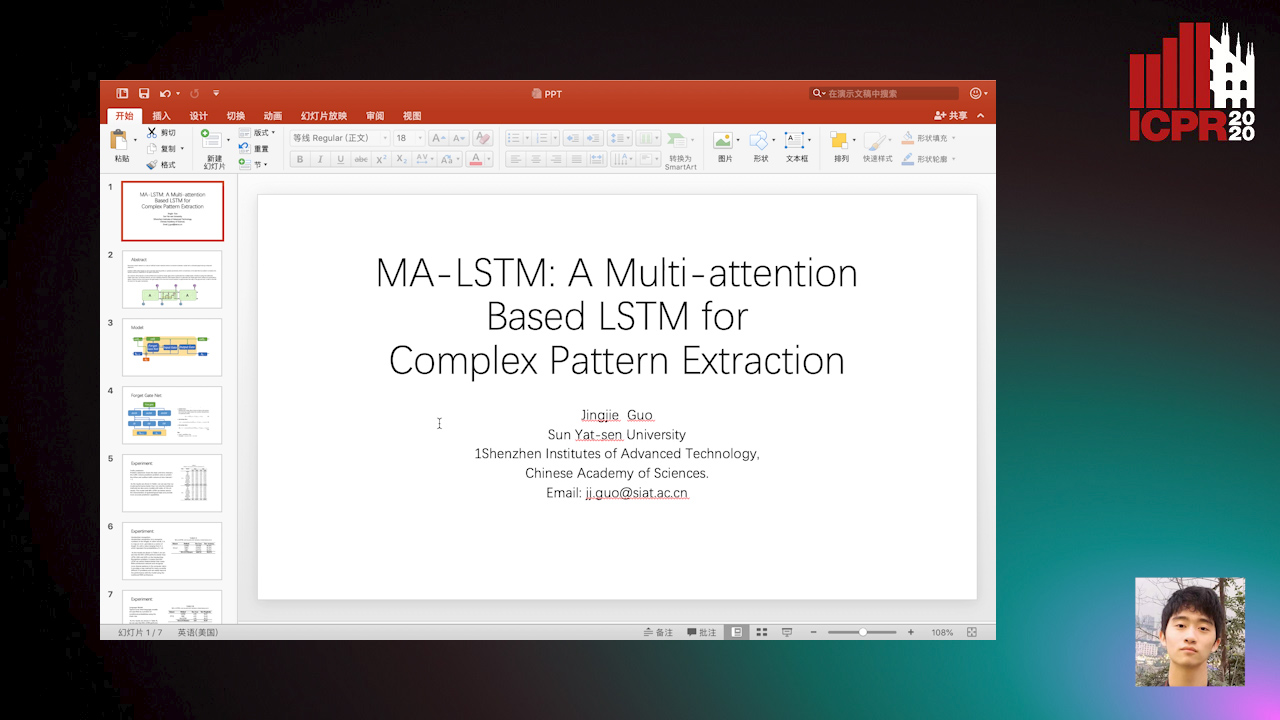
Auto-TLDR; MA-LSTM: Multiple Attention based recurrent neural network for forget gate
Abstract Slides Poster Similar